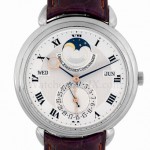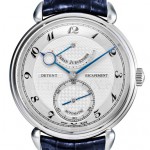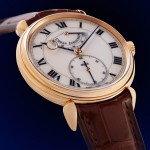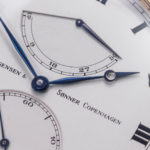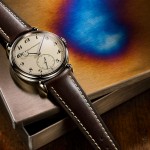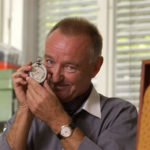Insight: Urban Jürgensen and the Royal Danish Academy of Sciences and Letters
A relationship that shaped Danish watchmaking.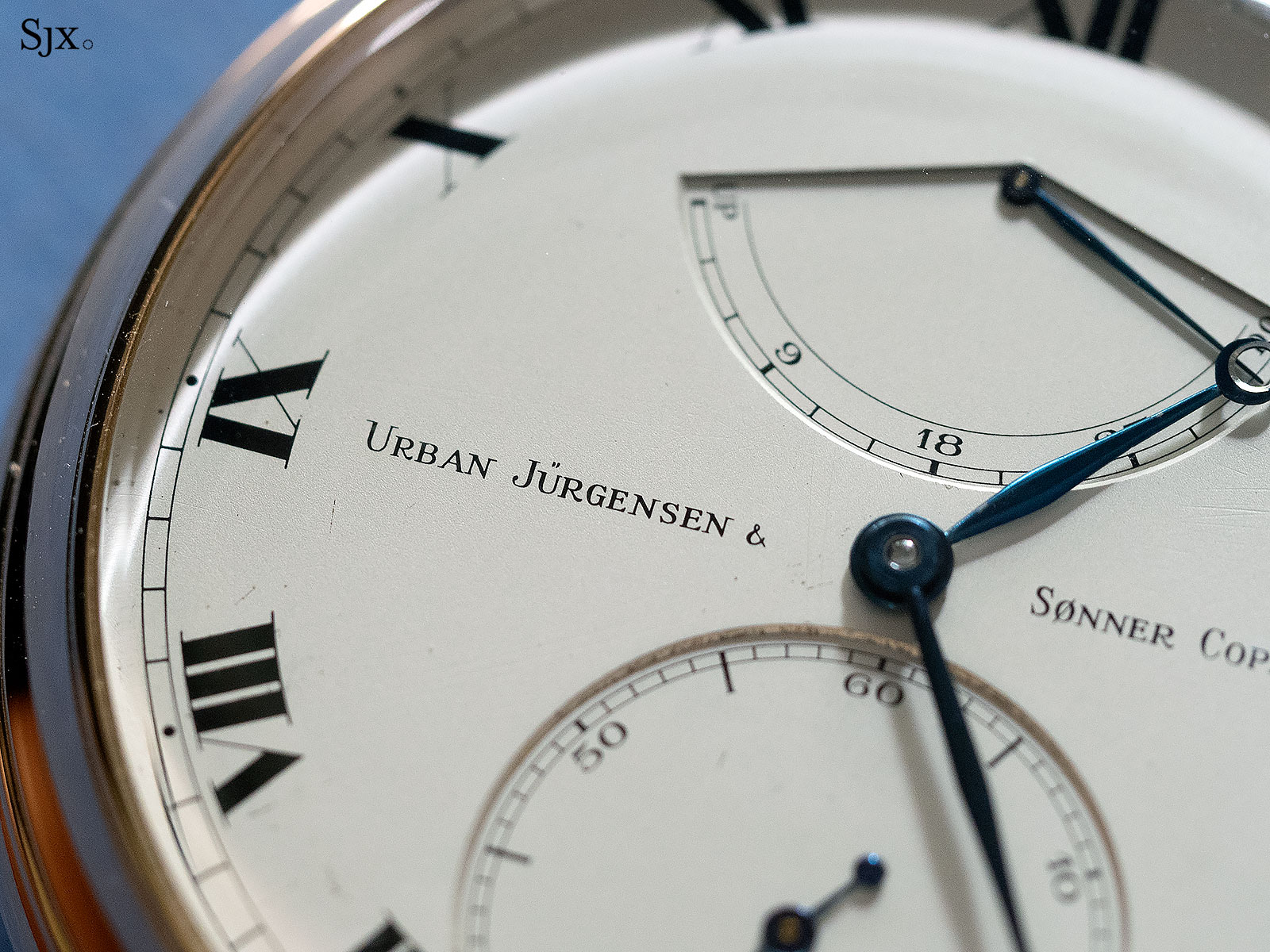
An academic, horologist, and innovator, Urban Jürgensen is today best known for giving his name for the watch brand that’s now run by independent watchmaker Kari Voutilainen and his daughter, Venla.
But Jürgensen was the most important watchmaker in Denmark in the early 19th century. He also developed a longstanding relationship with the most important Danish scientific society of the last three centuries, the Royal Danish Academy of Sciences and Letters (RDASL). This article explores the relationship that shaped his work on clocks and watches.
A need for precision
Being a horologist in Denmark at the turn of the 19th century was not necessarily a very noble job. A handful were highly regarded workmen, but none were on par with scientists on the social ladder.
Astronomers were buying English precision clocks for observatories and sailors still navigated by the movement of celestial bodies[1]. But times were changing, chronometers were already known to the king and government of Denmark, and the benefit of precision timekeepers for various types of expeditions was already becoming known around Europe.
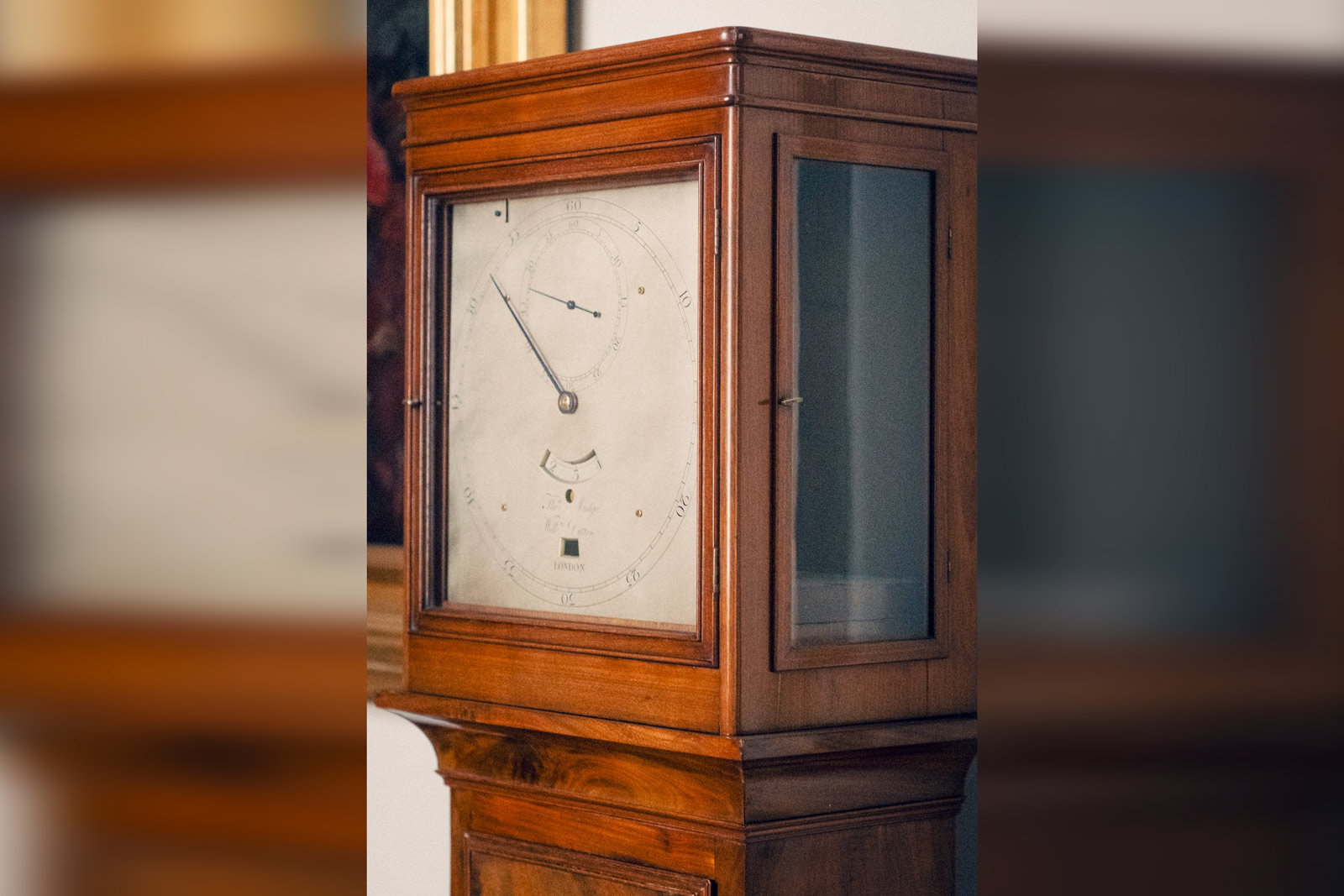
Mudge & Dutton astronomical regulator clock. Previously in the Observatory of Copenhagen, now located in the offices of the Royal Danish Academy of Sciences and Letters. Image – The Royal Danish Academy of Sciences and Letters/A.B.L.
As international conflicts were at the time were a limiting factor in importing chronometers from foreign countries, attempts were made to train chronometer makers in Denmark. Early attempts at domestically made chronometers took place during the late 1760s to 1780s.
During those years, Jean Abraham Armand, a watchmaker from the southern part of Jutland in Denmark, worked on making relatively affordable marine chronometers modelled on John Harrison’s invention.
Already in 1769, he showed a chronometer to a Professor Kratzenstein in Copenhagen. Hence, just two years after the publication of the description of Harrison’s H4, Armand had finished a timekeeper that he showed to those interested[2].
Armand was encouraged by the RDASL to proceed, however, in the style of the French chronometer makers like Berthoud and Le Roy rather than Harrison’s English manner[3]. After a successful trial of two chronometers in the observatory of Copenhagen in 1778, it was decided that they should be tested at sea.
This was done on a voyage to the West Indies, a Danish colony at the time, from 1782 to 1783. After the voyage, which was carried out, and later described in full, by Admiral Poul Løwenørn, he concluded that the chronometers could, with some modifications to the temperature compensating arrangement, be most useful for the kingdom of Denmark.
Thus, the king commanded Armand to stay in Copenhagen to make two chronometers per year. The chronometers did however never prove to be useful, as there were various issues with them, including the known temperature compensation problem, but also a half-second train, beating just 7200 times per hour[4].
Twenty years after the voyage, in 1803, Løwenørn eventually deemed the chronometers useless. The thirteen chronometers that had been made by Armand were sold at auctions in 1828 and 1830[5].
Hence, with no established and successful Danish chronometer makers to learn from, an aspiring clockmaker had to go abroad.
The Grand Tour
As very little has been published about Urban Jürgensen (UJ) to date, a brief summary of his early life is appropriate.
UJ was born in Copenhagen in 1776 and from the very beginning, he and his siblings were involved with watchmaking. Their father, Jürgen Jürgensen, was a prominent watchmaker himself. The company made some of the very best watches in Denmark at the time and were watchmakers to the royal court[6].
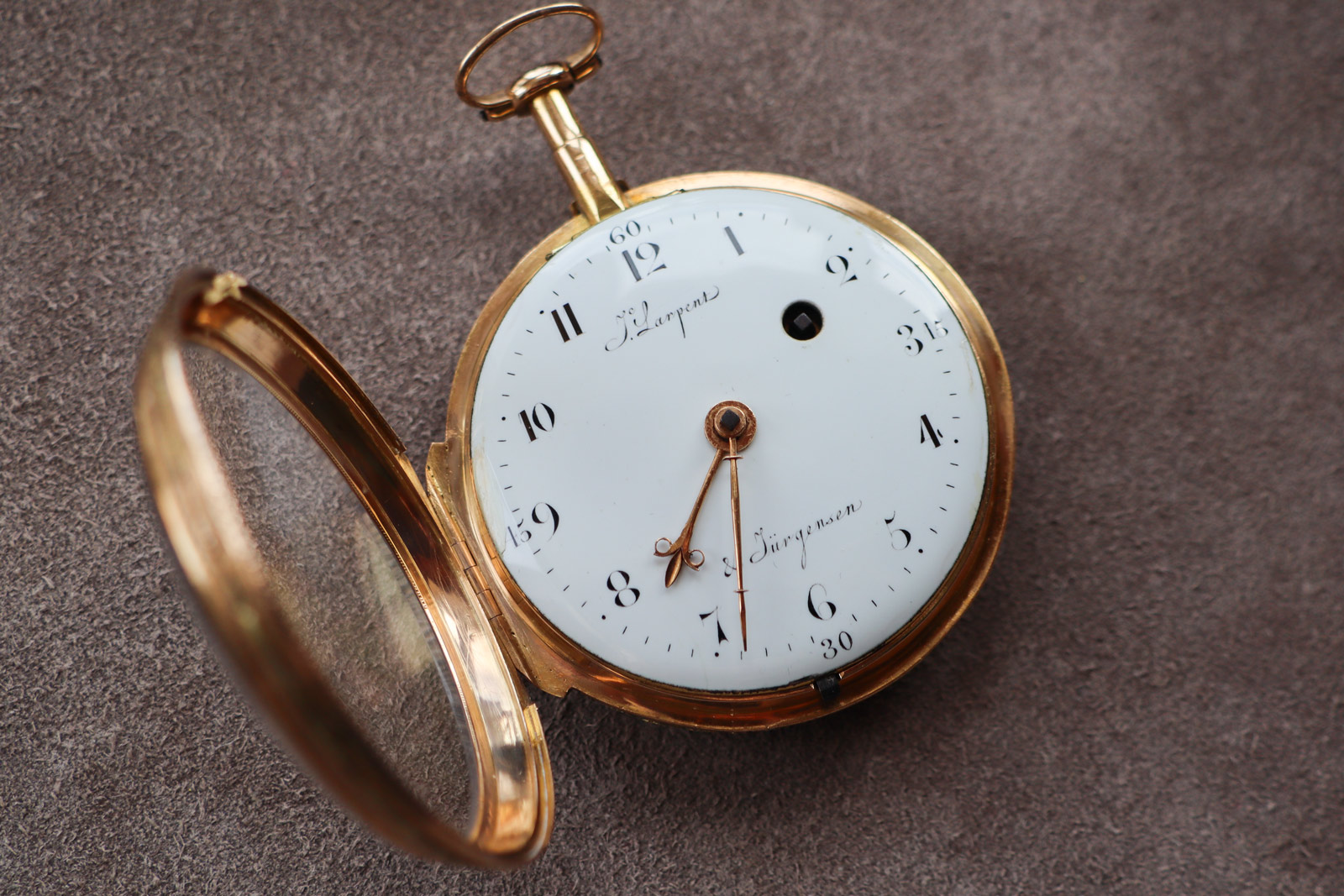
A typical Larpent & Jürgensen gold pocket watch from the early 1800s. Image – Anonymous collector
UJ quickly showed interest in following in his father’s footsteps. With an incredibly clever mind and a great deal of dedication, UJ learnt the trade in his father’s workshop. He was then sent on a Grand Tour to experience the horological centres of Europe and to see the technical developments that had not yet reached Denmark.
Luckily for UJ, his father had business associates and friends in these centres, including Jaques Frédéric Houriet in Switzerland. Thus, Houriet’s workshop in Le Locle became the first stop on his horological voyage.
UJ and Houriet got on along well and after approximately 18 months of learning about Swiss watchmaking and chronometry, UJ was sent off by Houriet (who later became his father-in-law) to the physicist Marc-Auguste Pictet in Geneva and later to Abraham-Louis Breguet in Paris, who was arguably the most influential watchmaker in continental Europe at the time.
Breguet inspired UJ, as much as Houriet had, which is clearly evident in UJ watches. However, as UJ’s biggest interest lay in the field of chronometry, Breguet suggested he leave Paris for London to see the chronometer makers there, including the Brockbank brothers and John Arnold.
In London, he once again found himself in an inspiring environment that, combined with his time at Houriet and Breguet, laid the foundation for his future chronometric work.
Back in Copenhagen
When UJ eventually returned to Copenhagen in 1801, he was encouraged by the government to start production of Danish chronometers. This was supposed to be established together with the little-known chronometer maker Etienne Magnin.
Jürgensen senior did however not agree with this, as he had been waiting for years for UJ to return to his workshop. As the words of his father weighed heavier than those of the government, UJ started working in the family business.
Here, his first task was to train his younger brother Frederik – not exactly what he had been dreaming about during his travels. UJ had to wait until 1811, the year of his father’s passing, to start working on what was closest to his heart: precision timekeepers. Before that, however, he did work on a few projects of his own.
That includes his book Regler for Tidens nöiagtige afmaaling ved Uhre[7] that was published in 1804 as the first book on watchmaking to ever be written in Danish. The book was published in French the next year and was originally written because members of the RDASL encouraged UJ to share his knowledge and findings obtained during his Grand Tour.
He did also, amongst others, develop a pocket thermometer, partly in collaboration with J.F. Houriet, for which he received a gold medal from Landhuusholdningsselskabet, a Danish institution equivalent to Britain’s Royal Society of the Arts.
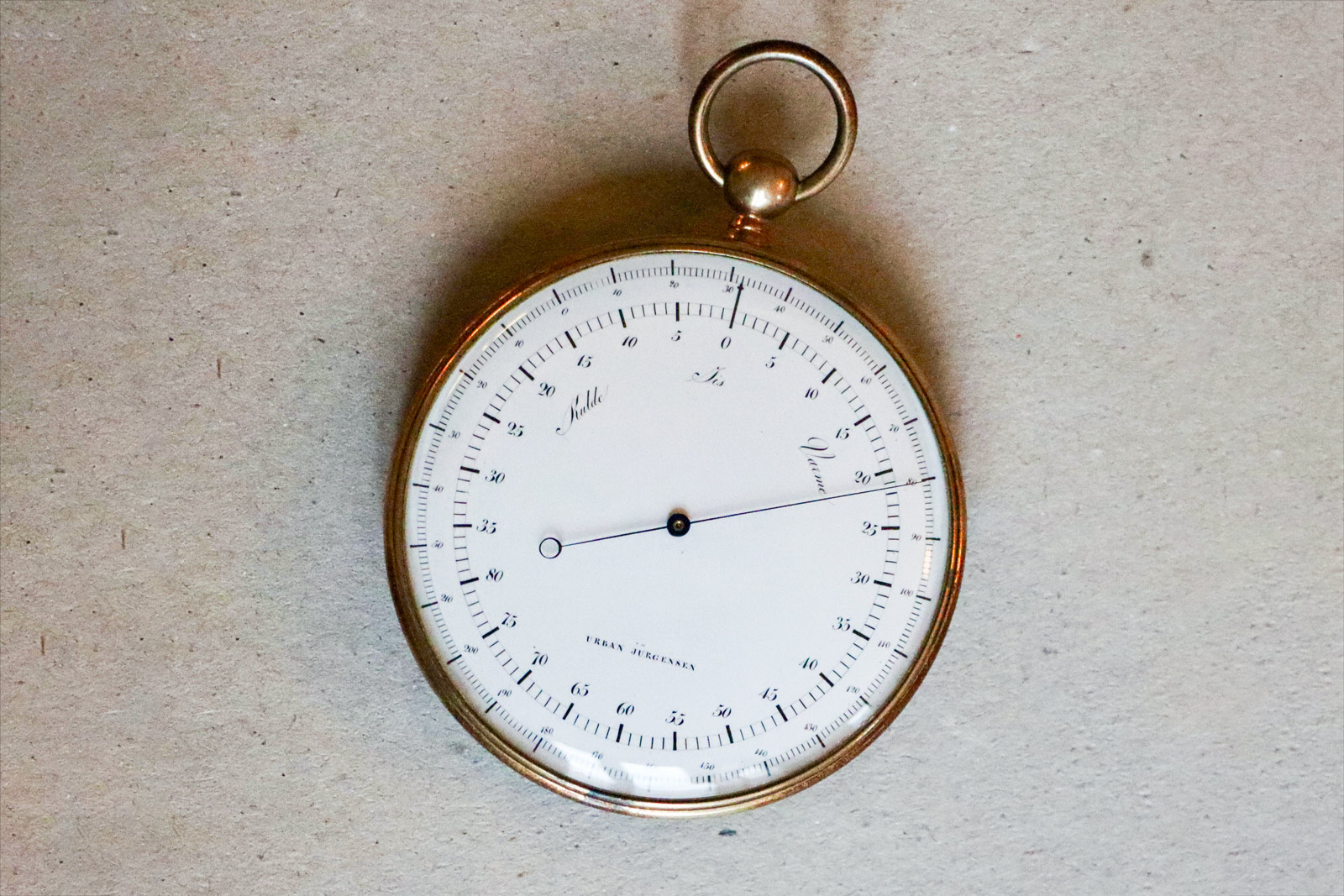
An Urban Jürgensen brass-cased thermometer showing the temperature in Reaumur and Fahrenheit. Image – Anonymous collector
He did however not have a lot of time to work on chronometers, as delving onto this branch of the horology was much too time consuming during this phase of his life.
A Jürgensen pocket watch with a spring detent escapement has nonetheless recently been discovered and remains the only known Larpent & Jürgensen-signed watch with a chronometer escapement. This watch is undeniably of an experimental character but does indeed show UJ’s interest in getting to understand the action, advantages and disadvantages of the escapement.
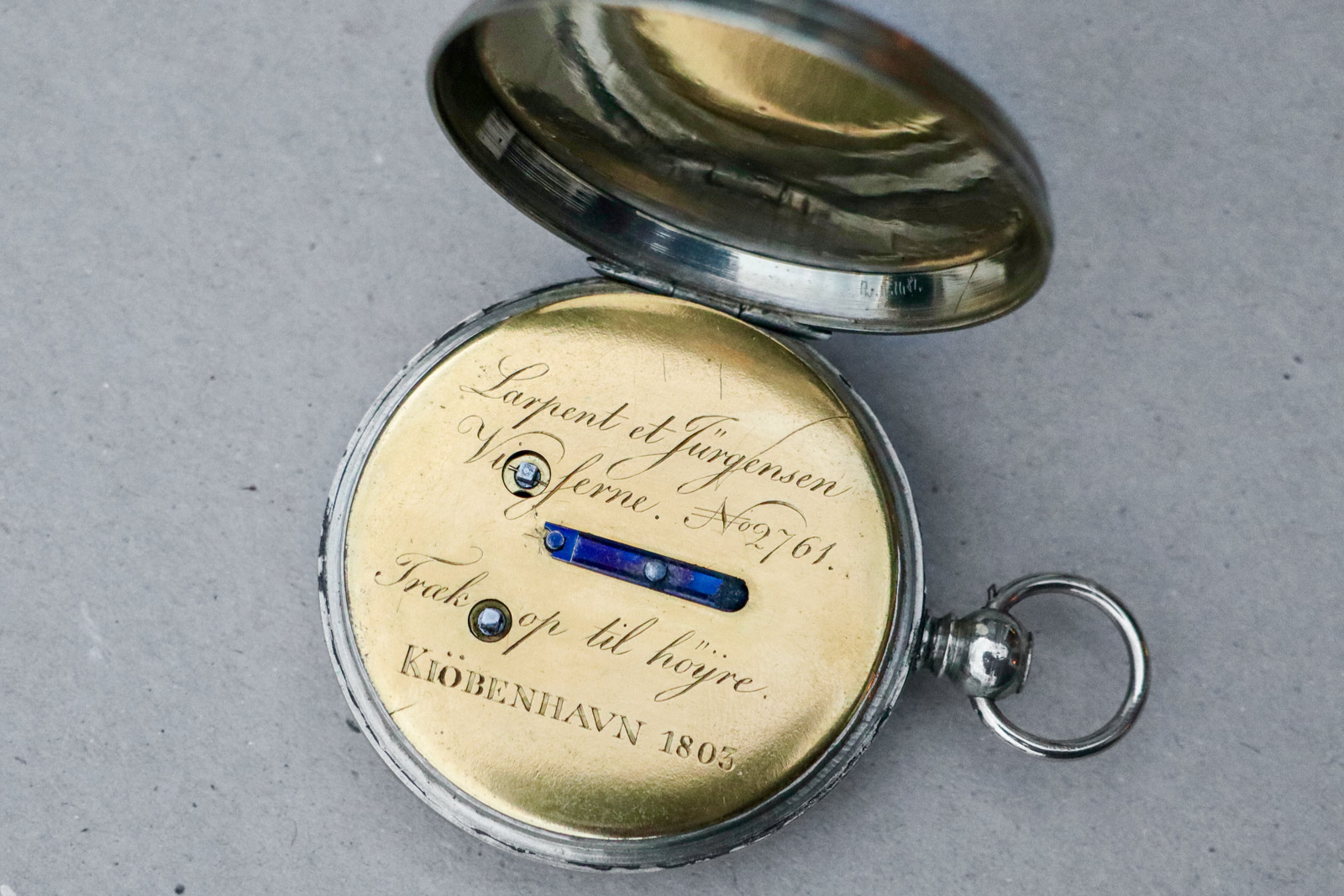
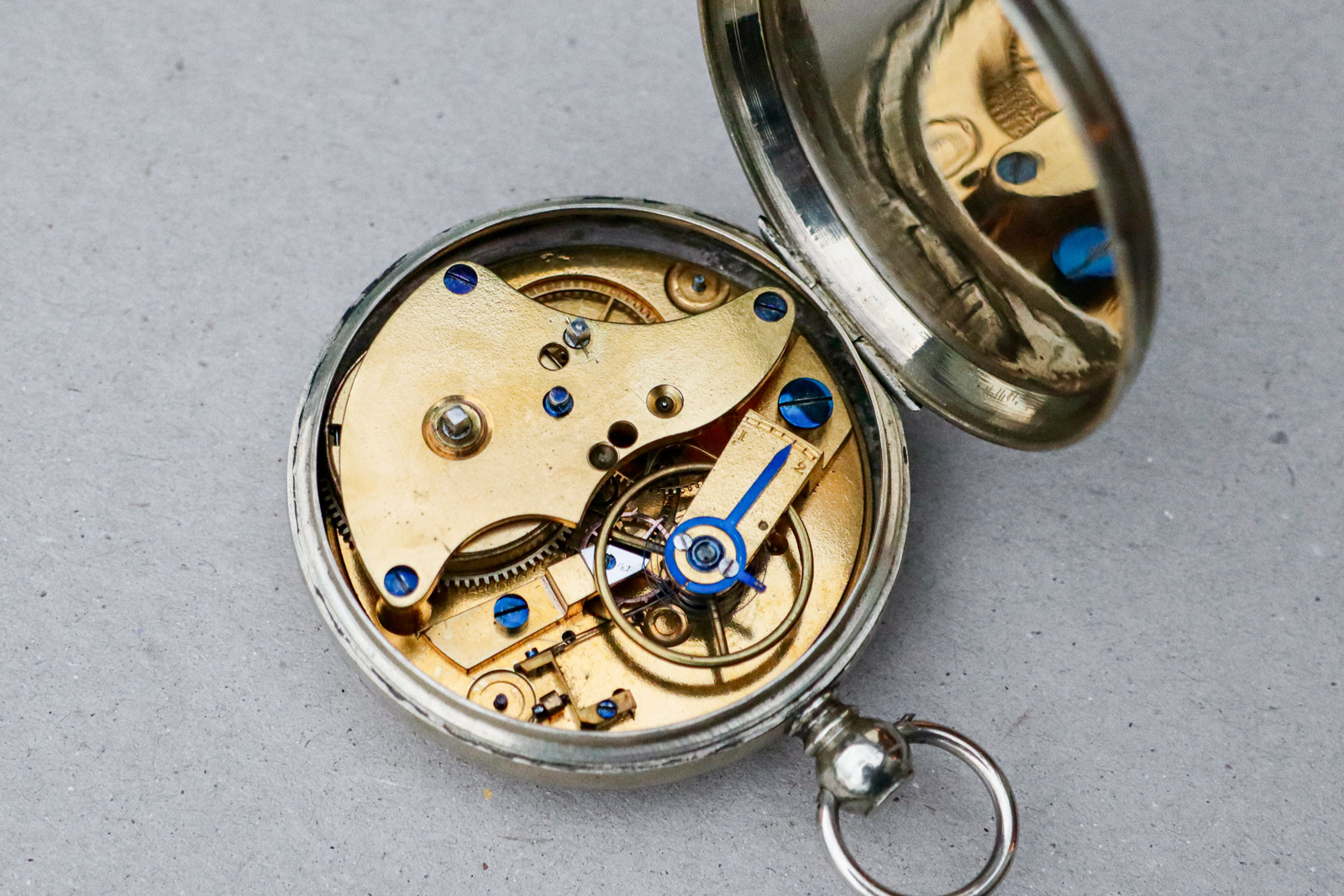
Case back and movement of the Larpent & Jürgensen pocket watch with a detent escapement. Apart from the escapement, the watch is not very chronometer-like. It has a brass balance, flat hairspring, no temperature compensation and is not free-sprung. Thus, it seems, that the watch was made to test the action of the detent escapement. The watch is numbered 2761 and was made in 1803, just two years after UJ’s return to Copenhagen and one year before he published his book. Image – Anonymous collector
After Jüles Jürgensen’s death, Frederik Jürgensen took over the family business and UJ could thus finally start his own company. The new enterprise soon attracted the attention of both other watchmakers who wanted to be trained there, but also from the government and especially the king.
UJ soon became supplier of chronometers to the navy and received a yearly income of 1200 speciedaler[8] for training two watchmakers per year in the art of chronometry. The first two trainees were his sons Louis Urban and Jules[9].
There are too many events in the life of UJ to mention in this article. Those interested in a comprehensive history of the life and work of UJ and his family should read John Knudsen’s The Jürgensen Dynasty[10].
A different field of interest
Producing high quality timekeepers is one thing, developing new ideas and techniques is something different entirely. This is one of the areas in which UJ differs from the rest of the Danish horological society of his time.
Apart from very few others, including Anders Christian Sparrevogn and Henrik Kyhl, UJ was the only Danish watchmaker in the first quarter of 1800 who published articles on horology. The articles written by UJ were always of a technical nature, except for his autobiography published in Magazin for Kunstnere og Haandværkere in 1829, one year before his passing.
There were mainly three publications that published UJ’s articles: Det Kongelige Danske Videnskabs Selskabers Afhandlinger (Treatises of the RDASL), Astronomische Nachrichten (Astronomical News) led by astronomer H.C. Schumacher in Altona, and Magazin for Kunstnere og Haandværkere (Magazine for Artists and Workmen) led by Dr Ursin in Copenhagen.
It is the first of these three periodicals that of primary interest for this article.
The Royal Danish Academy of Sciences and Letters
Apart from publishing its scientific journal, the RDASL was a society for the most gifted and learned scholars within the kingdom of Denmark and beyond. Noted foreign scientists were invited to become members of the Academy, including Einstein and Darwin.
The Academy, which was founded in 1742, was divided into different membership “classes”, namely the historical, physical and mathematical classes[11]. The vast majority of the members were making a living in their “class”, but some were wealthy enough to have it merely as a serious hobby, such as A. W. Hauch, who later became president of the RDASL[12].
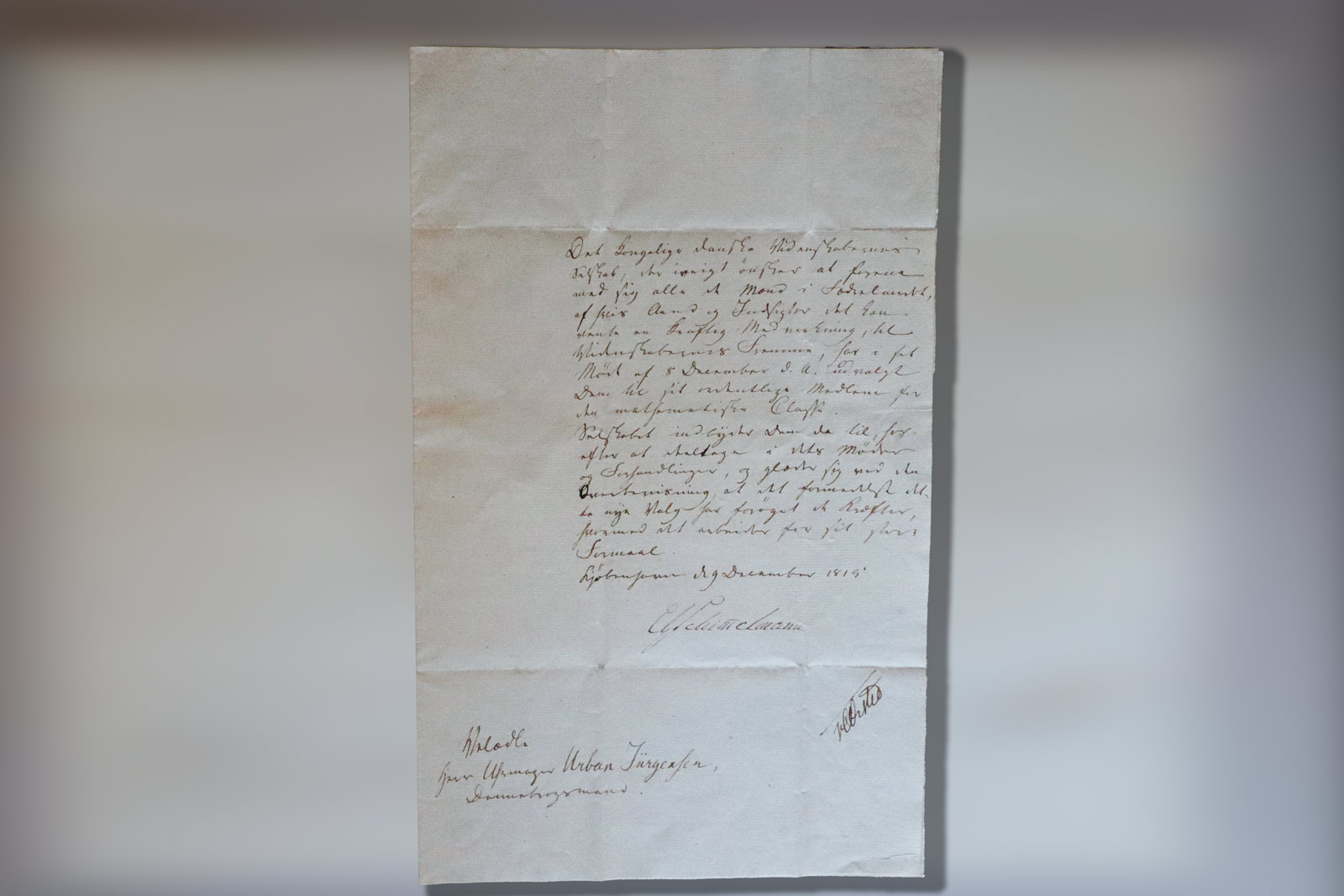
The invitation from the Royal Danish Academy of Sciences Letters to Urban Jürgensen. The letter is signed by the president of the Academy, Count Ernst Schimmelmann and general secretary Professor H. C. Ørsted. Image – Anonymous collector
Until 1815, no horologist, let alone a workman, had been invited to become a member of the Academy. That changed when the now world-famous physicist H.C. Ørsted was appointed secretary that year.
As opposed to the previous secretary, astronomer and professor Thomas Bugge, Ørsted was in favour of Urban Jürgensen, who had earlier been suggested by another member of the Academy, but with no luck[13].
It was Admiral Poul Løwenørn who 11 years earlier, based on two treatises on a new astronomical pendulum clock design (1) and on the hardening of steel springs (2), had encouraged Bugge allow UJ to become a member of the Academy. Bugge declined but did, with the rest of the board, award UG the silver medal for the second of the two treatises[14].
Interestingly, Heinrich Christian Schumacher from Altona became a member of the RDASL on the very same day as UJ. Bugge was very much against Schumacher, so much so that although Schumacher was also astronomer to the Danish king, Bugge would not let him work in Copenhagen. Hence, he stayed in Altona (now Germany) where King Frederik VI paid for the construction of an astronomical observatory for Schumacher’s use[15].
After the death of Bugge, Ørsted had no reason not to appoint this internationally recognised astronomer. Schumacher and Jürgensen became great colleagues and Schumacher would use UJ’s chronometers for various observations, as well as one of his astronomical pendulum clocks. Schumacher stayed in Altona for the rest of his life, as many of his colleagues resided in the area, including Kessels, Gauss and Repsold.
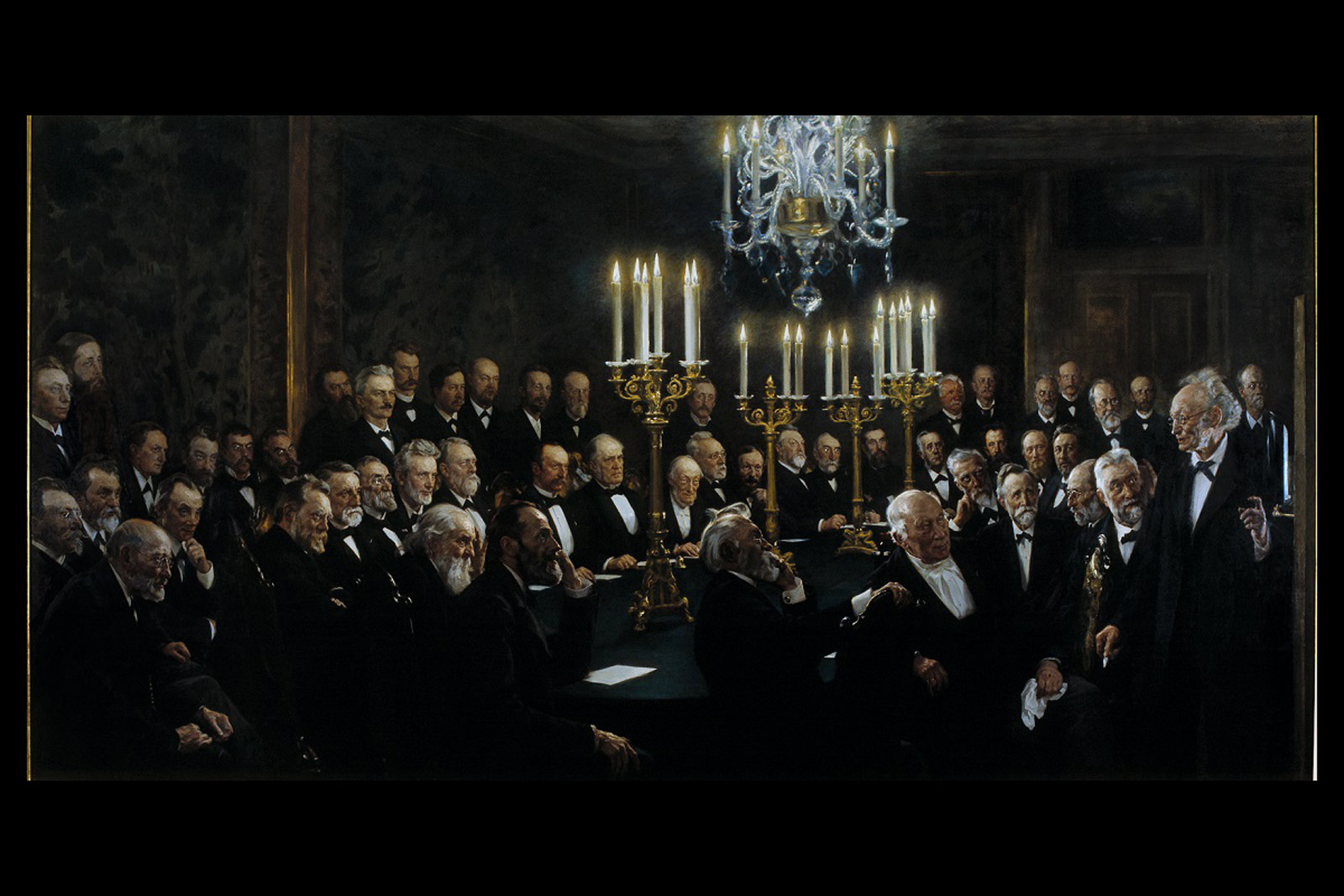
Painting by Danish painter P. S. Krøyer depicting a meeting in the RDASL. This painting, painted in the years 1895-97 is hanging in their meeting room and remains the largest painting ever done by Krøyer. Image – A meeting at the Royal Danish Academy of Sciences and Letters, 1897, by P.S. Krøyer. Oil on canvas, 266,7 x 519,4 cm. The Royal Danish Academy of Sciences and Letters. Gift from the Carlsberg Foundation, 1897.
Scholarly contributions
As stated above, it is the articles published in the RDASL’s journal that are of main interest for this article. UJ wrote and had the following three articles published (translated from Danish):
1) About Isochronism of the Pendulum and a suggestion to, in an easy way, make the Pendulum Swings of equal Arcs in astronomical Pendulum Clocks (1821),
2) Description of a new Metal Thermometer (1823) and,
3) About the Influence of the Air on the Regulator of astronomical Pendulum Clocks and Longitude Watches (1828)[16].
All three can be freely accessed on the RDASL’s website[17]. They are however all written in Danish. Hence, the main points and findings of the three articles will be touched upon below:
About Isochronism of the Pendulum and a suggestion to, in an easy way, make the Pendulum Swings of equal Arcs in astronomical Pendulum Clocks (1821):
UJ begins the article by stating that the advancement of horology has, since the introduction of the pendulum, been driven primarily by scientists and only later by horologists.
The horological feat closest to keeping perfect time, is the astronomical pendulum clock. The various perfections, such as jewelled pivot holes, maintaining power and temperature compensation are mentioned.
However, one problem is still apparent in most clocks: varying arcs of the pendulum caused by dust, wear and a change in the viscosity of the oils applied to the pivots and the escapement.
He goes on to explain Christiaan Huygens’ concept of cycloidal cheeks, but criticises it, as it does not take the humidity of the clock’s environment into account. Huygens does give another suggestion to minimising this issue of the varying arc, namely that of having a relatively small pendulum arc.
But as UJ correctly states: minimising a problem is not the same as solving it. Hence, he proposes a solution to the problem: an arrangement on the weight on which small weights could be added when needed – i.e. when the oil thickens etc. This would increase the driving force of the clock and thus equalise the effect of increased friction.
To help the user (most likely an astronomer) in knowing when weight should be added, UJ suggests adding a hand – or similar – to the pendulum that points to a protractor indicating the exact arc of the pendulum. A magnifying glass could be mounted over the protractor to ease this manoeuvre.
Moreover, he suggests that the arcs should be increased (as opposed to Huygens’ suggestion), as the influence of the changing viscosity of the oil will be decreased (1), and as the minimal but noticeable shaking of the floor in the observatory will have a relatively smaller effect on the pendulum (2).
UJ’s first ever astronomical pendulum clock featured an arrangement like the one he proposes in the article. This was made for and delivered to Professor Hansteen in Christiania Observatory (now in Oslo) in 1823. A thorough description of this clock, including pictures, can be found in page 124 of Knudsen’s book.
The way in which weight is added is via a small bowl placed underneath the weight. Small lead shots could then be places in the bowl. The Christiania clock features a note on which the effect of placing either a small or a large lead shot are outlined[18]. UJ made a total of six astronomical pendulum clocks. As mentioned above, Schumacher bought one of them for his observatory in Altona.
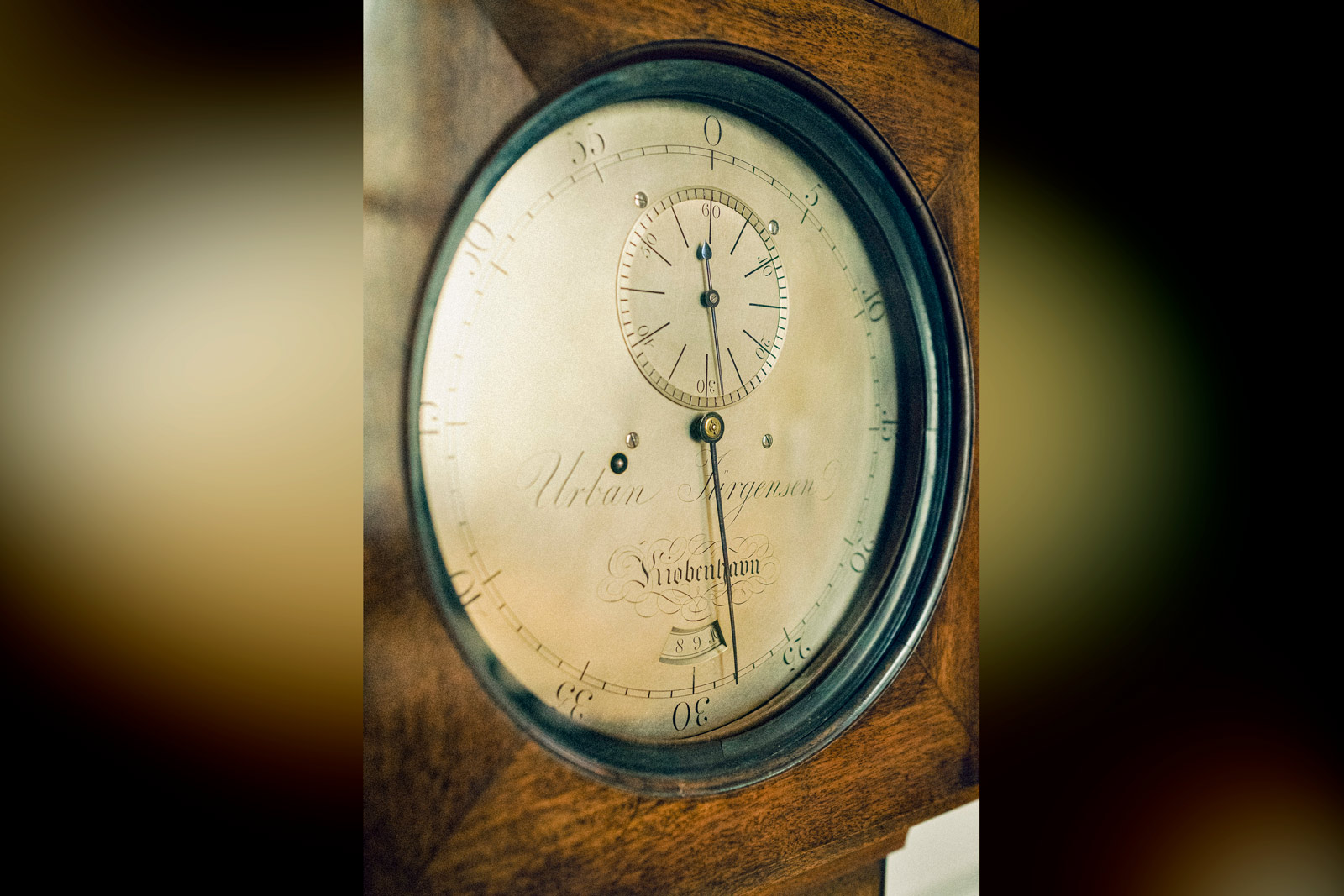
Urban Jürgensen astronomical regulator clock which was previously in the Observatory of Copenhagen. Image – The Royal Danish Academy of Sciences and Letters/A.B.L.
Description of a new Metal Thermometer (1823):
As mentioned previously, UJ invented a pocket thermometer with his colleague and father-in-law J. F. Houriet. The initial design, which was presented to the RDASL more than twenty years earlier, only indicated the present temperature. This new design included an arrangement that allows the user to observe the lowest temperature since the last resetting of the hand.
UJ starts the article by applauding the mercury thermometer and calls it one of the most perfect instruments in the world of natural sciences. The metal thermometer is however, he states, much more portable and rugged than the former.
Moreover, the metal thermometer is more dependable in conditions where the temperature is well below nil degrees, as the mercury may freeze in such an environment. The thermometer described in this article is of a slightly larger size than the first iteration and thus meant as a stationary tool for better readability.
UJ goes on to describe the construction of the thermometer, using two illustrations – one of the front and one of the back of the device.
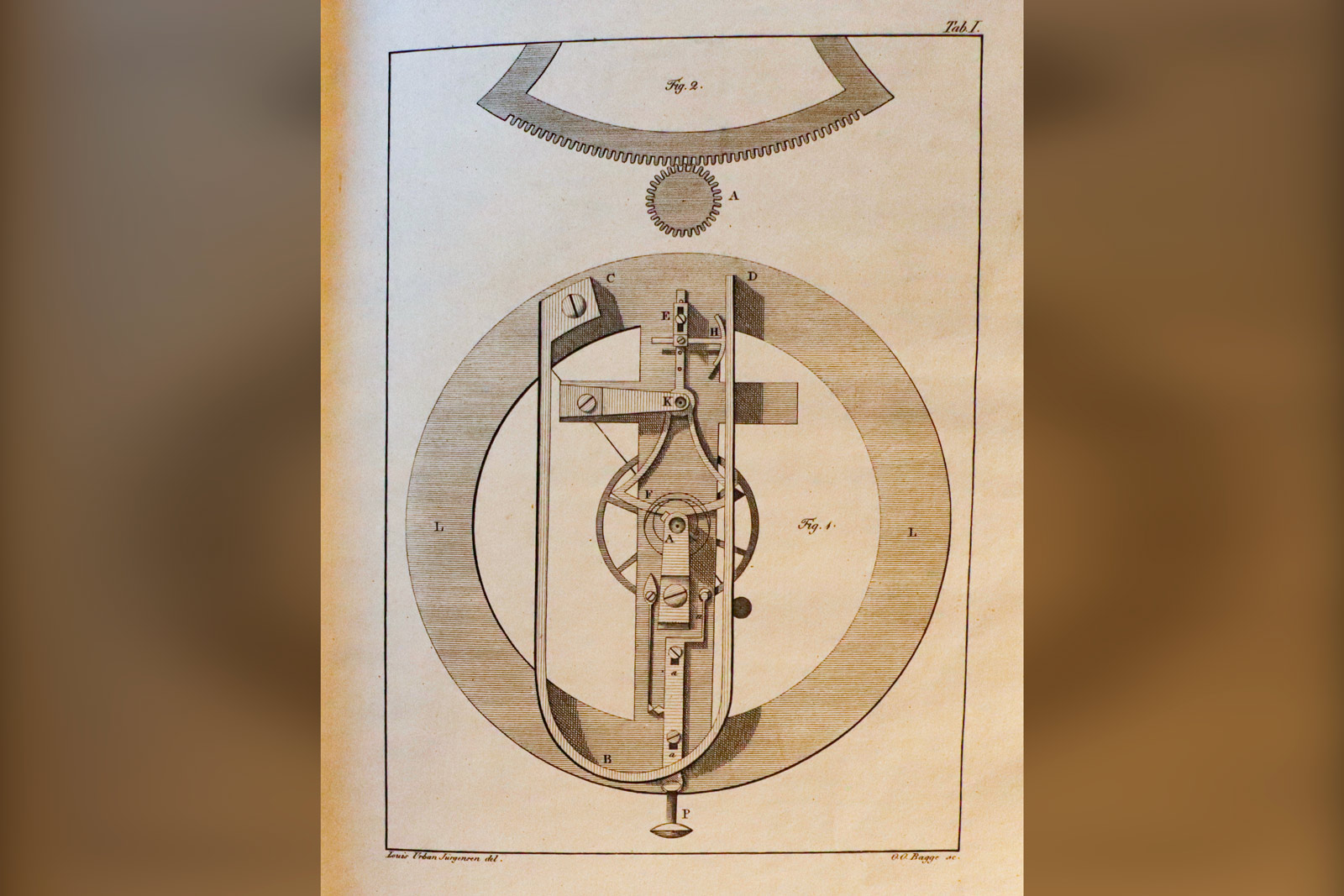
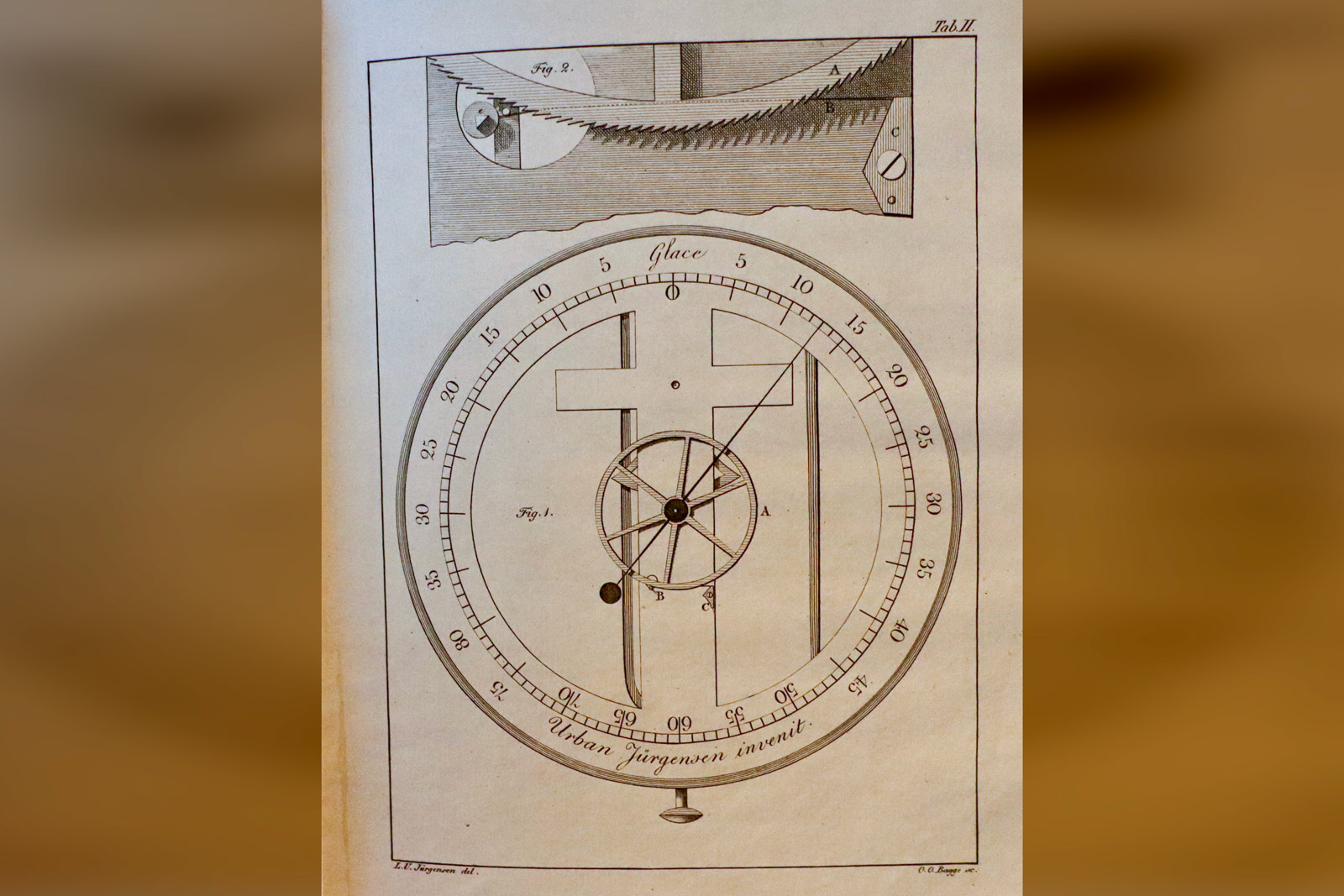
The plates brought in the article. They depict the front and the back of the thermometer. Image – Anonymous collector
In short, the thermometer works by having a U-shaped piece of fused brass and steel that, when being influenced by the variations of temperature and thus moving either in- or outwards, acts on a sector-shaped piece of brass attached to another brass piece of sector shape which, via a pinion, moves the hand.
A ratchet wheel is attached to this pinion (visible on the dial side), which, when activated by the pusher at the six o’clock position, moves the hand only when the temperature is decreasing. Hence, the lowest temperature since activation will be indicated on the dial. When neutralised, the hand will show the current temperature. The arrangement is show in the illustrations above.
After describing the construction, UJ gives a few remarks: 1) For the thermometer to be as accurate as possible, the pinion should be made with as many teeth as feasible. In this one, there are forty teeth[19]. 2) The spring used in the activation of the minimum temperature arrangement must be made very weak to avoid unwanted friction. The spring can be seen in table II, figure 2 above. 3) The metal case into which the thermometer is built should be thin and have great heat conducting properties. This is to avoid the thermometer losing its mechanical properties.
About the Influence of the Air on the Regulator of astronomical Pendulum Clocks and Longitude Watches (1828):
This article is somewhat longer than the previous two and is an analysis of the influence of variations of the air, be it pressure, density or resistance. UJ starts by noting how incredibly precise chronometers and pendulum clocks have become. He mentions the experiments undertaken by astronomer Bessel, published in Astronomische Nachrichten no. 28, where Bessel shows how the air density influences the rate of clocks. Bessel does however not take the air resistance into account.
UJ writes that the air resistance is much more apparent in chronometers than in clocks, as the balance of a chronometer passes through approximately twelve to eighteen inches of air per second, as opposed to slightly less than three inches in astronomical pendulum clocks.
Moreover, the surface area of the balance is relatively larger in the chronometer than that of the clock, namely the pendulum. However, the factual influence is not analysed. Hence, the main aim of the article is to test various box- and pocket chronometers in different environments of varying air pressure.
The experiments were made by using an air pump and a glass bell made available to UJ by H.C. Ørsted, who also offered his instructions and advice. UJ tested the following chronometers: UJ no. 17, UJ no. 31, UJ, no. 38, Arnold no. 82 and Arnold no. 438.
After testing the chronometers the first time, he sub-concludes that those chronometers with larger balances suffer more from changing amplitudes than those with relatively smaller balances. Hence, box chronometers (which, on average, have larger balances) need a larger power supply to maintain their rate.
UJ suggests that the best chronometers are of a semi-large size to minimise the air resistance of the balance, whilst also being large enough for coping with the issues connected to a changing viscosity of the oil. The optimal movement size is, according to him, between two to three inches in diameter.
There are however, as he notes, other ways of decreasing the air resistance: by making the weights of the balance more aerodynamic. By making bean-shaped weights instead of trapezoidal, the surface area that breaks the air is greatly reduced – this idea is borrowed from the making of pendulum bobs. The arms of the balance may be wedge-shaped on both sides to reduce the resistance even more.
Lastly, UJ suggests the use of platinum or gold for the compensating weights as opposed to steel or brass. As the mass density of the former two materials is higher, the amount of material could be reduced which would again lead to a smaller surface area.
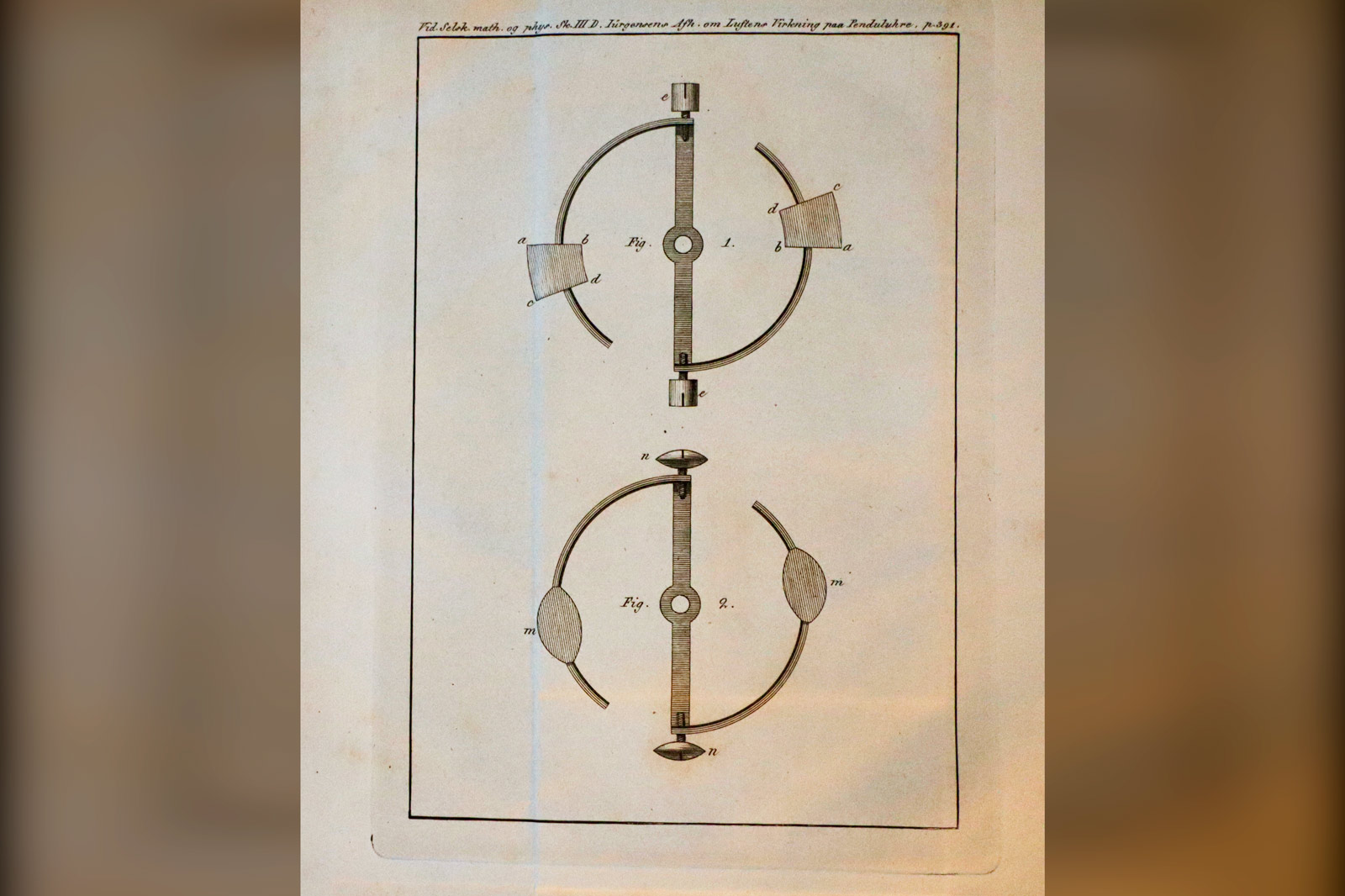
This plate from the 1828 article shows a regular chronometer balance with trapezoidal weight above, and the Jürgensen chronometer balance below. Even the mean time screws on the latter have an aerodynamic shape. Image – Anonymous collector
During a second trial of the chronometers listed above, he finds that some go faster in thin air, some slower. Arnold no. 82 accelerates, Arnold no. 438 decelerates. He thinks that the reason for this is a lack of isochronism.
His own chronometers[20], no. 31 and 38, on the other hand, both have hairsprings that provide a slightly faster going when the amplitude is decreased (which is what happened when he altered the air density) and have an amplitude, under normal conditions, of circa 450 degrees.
The influence of the changed air density is however negligible on these. Although the influence in his experiment proves insignificant on his own chronometers, UJ still suggests the use of the above-mentioned improvements to reduce the possible negative impacts of barometric changes.
The times of Urban Jürgensen
It is made clear in the articles mentioned above that UJ was not a watchmaker that did what his fellow watchmakers did – at least not without a healthy portion of scepticism. His main objective throughout his working life, especially after starting his own company, was to improve the instruments of his craft – watches, chronometers, clocks and other horological precision instruments.
He was a collector of information and thus had a clear understanding of the giants on whose shoulders he was standing himself. Numerous of the important books from the 18th century from UJ’s personal collection, including those from Berthoud, Lepaute and Harrison, are kept in the Watch- and Clockmaker’s Guild of Copenhagen.\
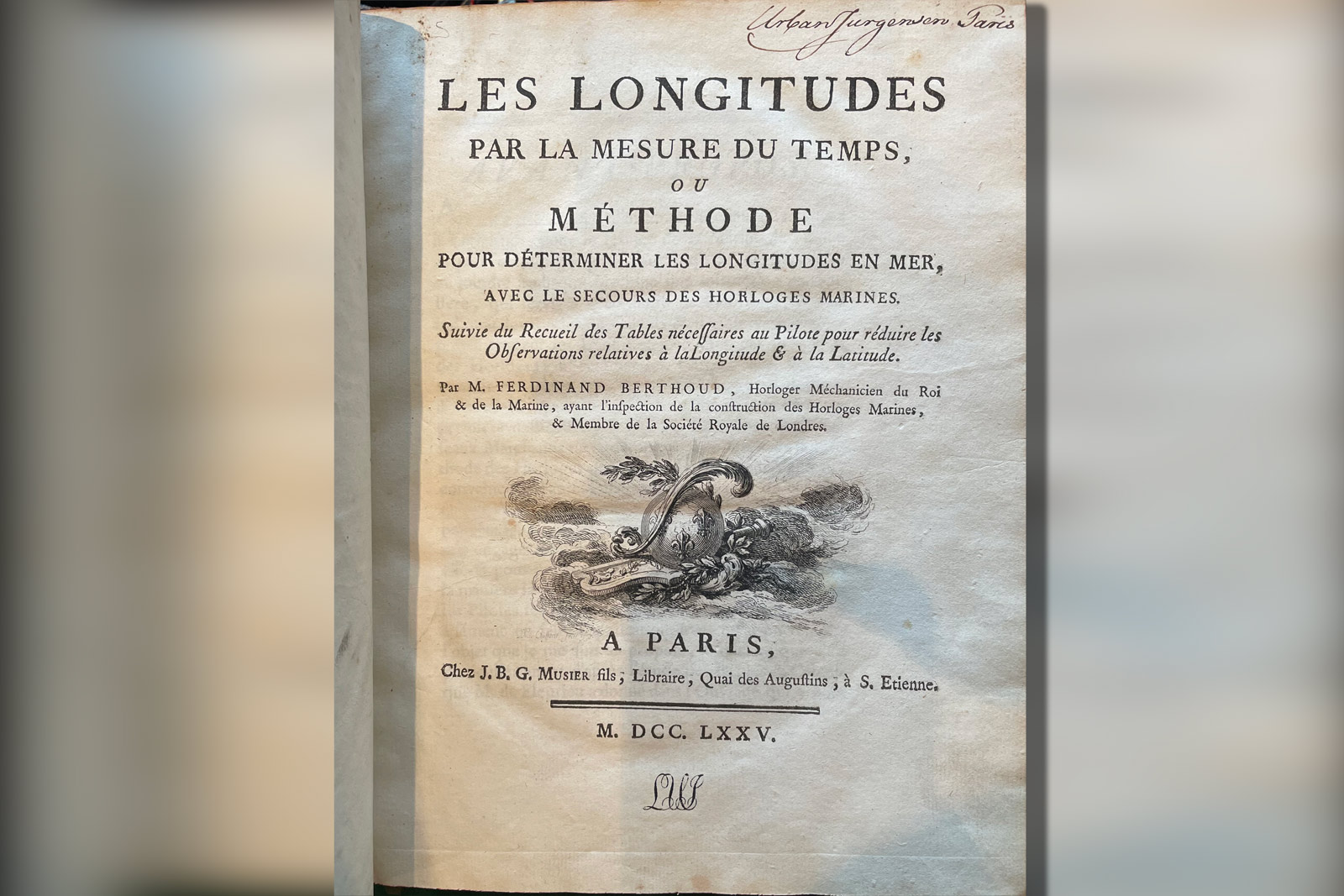
One of the many books in the library of the Watch- and Clockmaker’s Guild of Copenhagen that belonged to Urban Jürgensen. Interestingly, this book seems to have been purchased during his time in Paris (see upper right corner). Moreover, the book bears the personal stamp of his son Louis Urban Jürgensen ‘LUJ’ at the bottom of the page. Image – The Watch- and Clockmaker’s Guild of Copenhagen
UJ’s approach to horology is not uncommon in Great Britain, France nor Switzerland, but it was very much so in Denmark at the time. The main reasons for UJ’s approach are firstly his access to the horological centres of the world via his father and father-in-law. He obtained an international perspective on the horological world and became friendly with some of the most prominent watch- and clockmakers in the world of his time.
Secondly, UJ’s membership of the RDASL gave him the best possible setting to sprout in. The Academy held monthly meetings in which the members could share the findings of their studies, be it in physics, philosophy, mathematics, or something different entirely[21].
Thirdly, UJ had a great patron in King Frederik VI. Supplying chronometers to the royal navy was reserved for the best chronometer makers and the privilege came with a safe income as well as a need to always be better than the competitors – both technically but also economically.
The King supported UJ early in his career and gave him royal privilege to produce chronometers in Copenhagen. Moreover, King Frederik VI bought quite a few important watches and chronometers from UJ to give as gifts for those deserving, such as admiral Krusenstern[22]. The Krusenstern chronometer is regarded as the finest, most luxurious chronometer made by UJ[23].
Lastly, UJ was interested in the fields surrounding horology, specifically physics and astronomy. He mostly knew what could and could not physically be done. If he was unsure, he had resourceful colleagues around him in various subjects. At the same time, he knew, via his colleague H.C. Schumacher, what the astronomer needed.
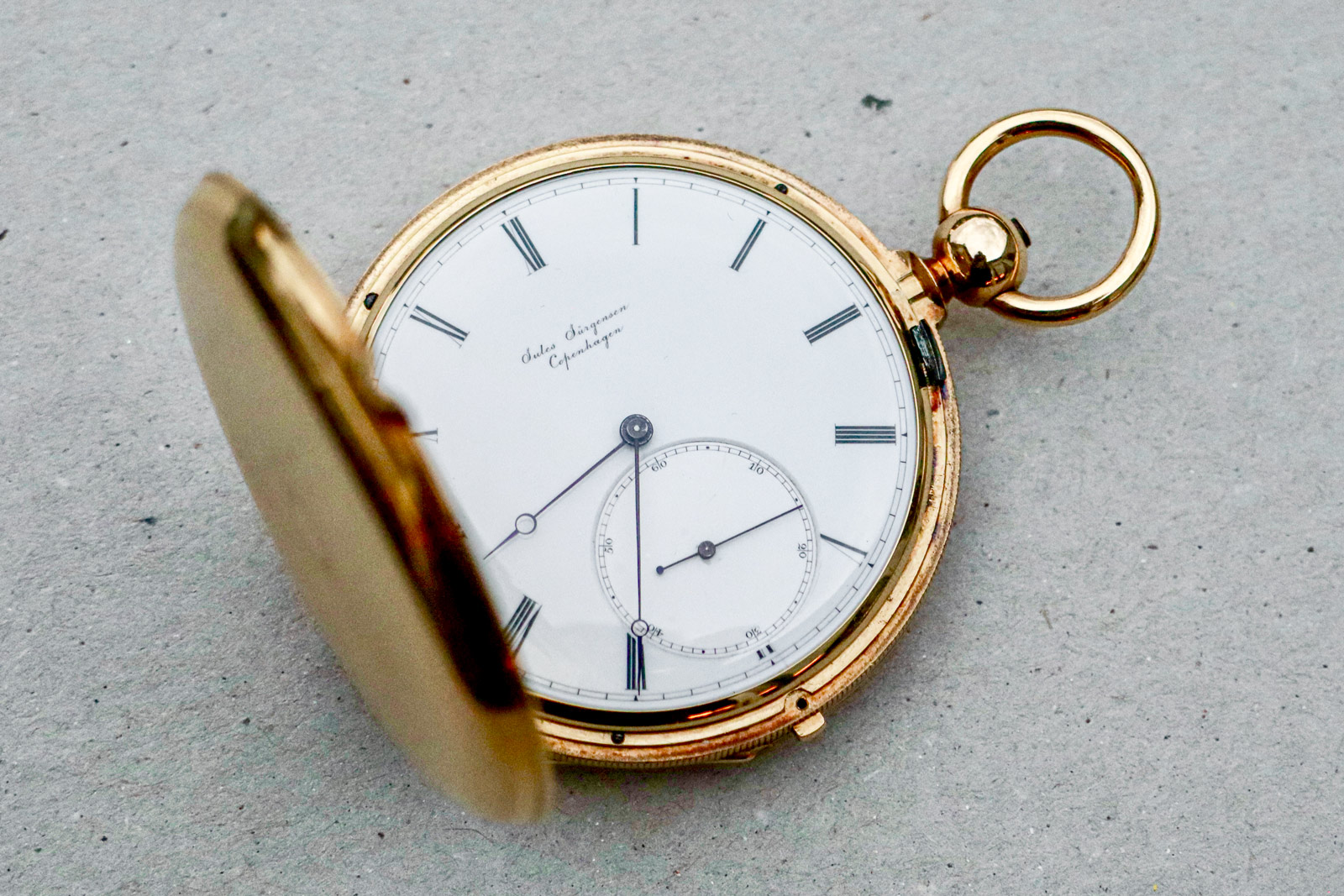
Jules Jürgensen no. 8946 (made in 1857-58) and Louis Urban Jürgensen chronometer no. 64 (1840s). Two unquestionably different watches from the sons of UJ. Image – Anonymous collector
This approach to horology is something that UJ’s sons, Louis Urban and Jules, whom he trained, inherited from him. They grew to become leading figures in the industry themselves – Louis Urban in Copenhagen making chronometers and Jules in Le Locle, Switzerland, making watches of the highest quality. They embarked on Grand Tours as their father did and visited the same workshops that UJ did before them. Both made written contributions to the subject as well.
Louis Urban was in particular keen on writing and was the one who published the second edition of UJ’s book from 1804. This was published in French, Danish and German in the years 1838 to 1842. Moreover, Louis Urban collected five of his father’s written contributions in a booklet titled Mémoires sur l’Horlogerie exacte. Being in French, it inevitably made the material accessible to many more, as compared to if it had been published in Danish. This work includes five plates and is quite scarce.
The lives and works of Jules and Louis Urban are stories of their own and deserve their own articles. Again, I can only point whomever that may be interest in their stories, in the direction of Knudsen’s book.
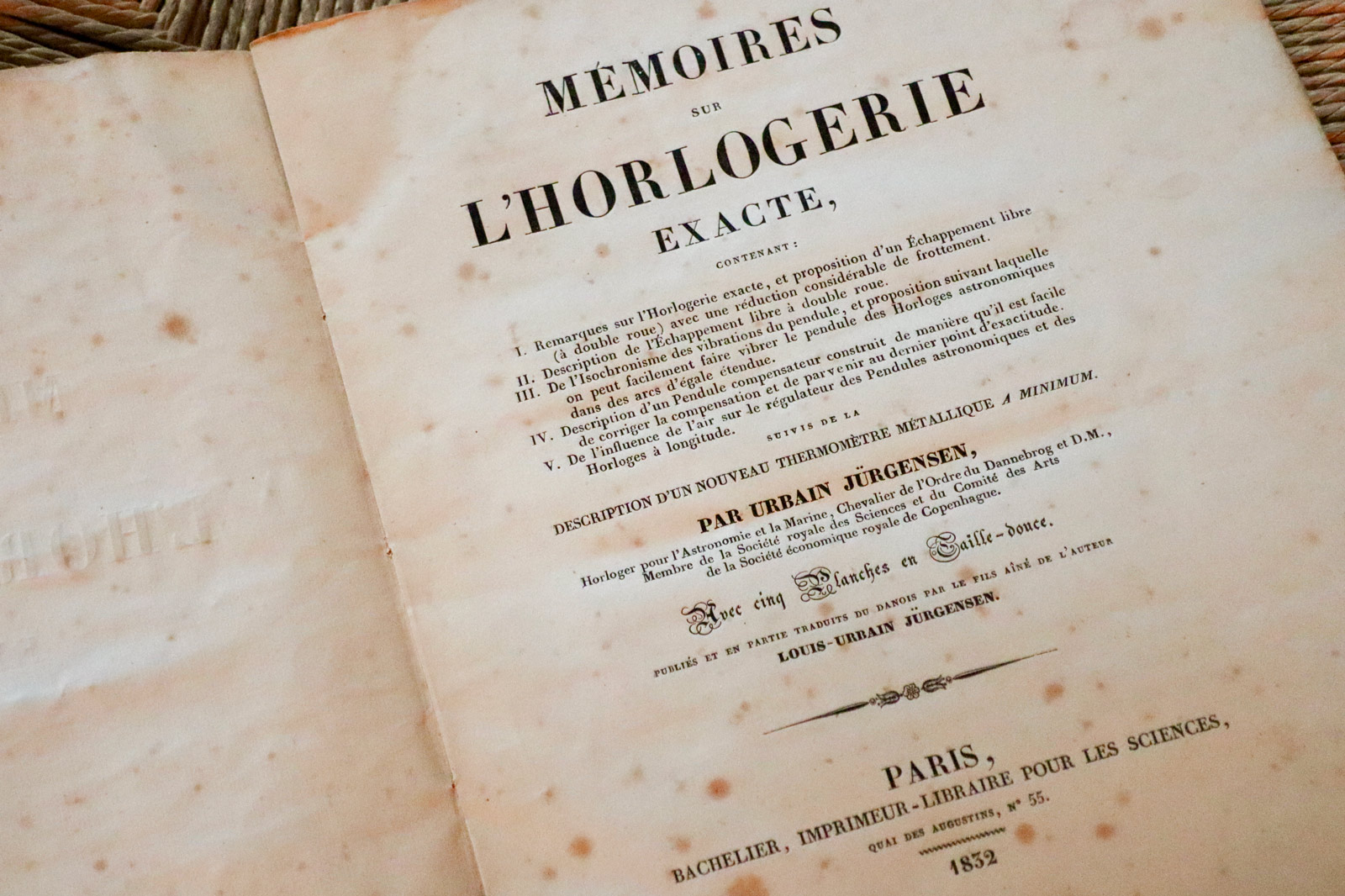
An overview of the five articles in Louis Urban Jürgensen’s ‘Mémoires sur l’Horlogerie exacte’. Image – Anonymous collector
Acknowledgements
I would like to thank Rune Bakkendorff, master watchmaker and board member of the Watch- and Clockmakers Guild in Copenhagen for his expertise on horology in general and help in gaining access to the Guild’s library.
Additionally, I would like to thank Rikke Reinholdt Petersen from the Royal Danish Academy of Sciences and Letters for precious information and for photographic material of the pendulum clock in the Academy’s collection.
The author is a watch specialist at Danish auction house Bruun Rasmussen. He is also an honorary member of the Danish Watch- and Clockmakers Guild in Copenhagen.
[1] Ejner Munksgaard, Rundetaarn, 1637-1937 (Copenhagen: Levin & Munksgaard, 1937), p. 87.
[2] Poul Darnell, ’En beretning om den danske flådes første kronometre’, Marinehistorisk Tidsskrift, no. 1 (February 2019), p. 7
[3] Poul Darnell, ’En beretning om den danske flådes første kronometre’, p. 7-8.
[4] Poul Darnell, ’En beretning om den danske flådes første kronometre’, p. 11.
[5] For a thorough analysis of the Armand chronometers and the voyage to the West Indies, Poul Darnell has written a 20-page report in Danish, which is available for free from the Danish Horological Society’s website: www.danskhorologiskselskab.dk
[6] John M. R. Knudsen, The Jürgensen Dynasty (Copenhagen: Antique Collector’s Club, 2013), p. 22.
[7] This translates to: General Principles Concerning Exact Timekeeping by Clocks and Watches.
[8] Danish currency
[9] Urban Jürgensen, ’Autobiography’, Magazin for Kunstnere og Haandværkere, no. 4 (Copenhagen: G. F. Ursin, 1829), p. 7.
[10] John M. R. Knudsen, The Jürgensen Dynasty (Copenhagen: Antique Collector’s Club, 2013).
[11] C. Molbech, Det Kongelige Danske Videnskabernes Selskabshistorie i dets første aarhundrede 1742-1842 (Copenhagen:RDASL, 1843), pp. 275.
[12] Molbech, Det Kongelige Danske Videnskabernes Selskabshistorie i dets første aarhundrede 1742-1842, p. 510.
[13] Dan Ch. Christensen, Naturens Tankelæser – En Biografi om Hans Christian Ørsted, (Copenhagen: Museum Tusculanums Forlag, 2009), pp. 386.
[14] Molbech, Det Kongelige Danske Videnskabernes Selskabshistorie i dets første aarhundrede 1742-1842, p. 410.
[15] Søren Andersen & Poul Darnell, ‘The history of Josiah Emery’s lever escapement gold watch no. 929’, Antiquarian Horology, volume 39 no. 3 (September 2019), 378.
[16] The original article titles are: (1) Om Isochronismen ved Pendlens Sving og Forslag til, paa en let made, at bringe Pendlen til at svinge i ligestore Buer ved astronomiske Pendeluhre (1821), (2) Beskrivelse over et nyt Metal-Thermometer (1823) and (3) Om Luftens Virkning paa de astronomiske Penduluhres og Længdeuhrenes Regulator (1828).
[17] www. publ.royalacademy.dk
[18] John M. R. Knudsen, The Jürgensen Dynasty (Copenhagen: Antique Collector’s Club, 2013), p. 124.
[19] The amount given in the article is 40 teeth. There are however not 40 teeth in the illustration.
[20] UJ no. 17 is not included in the second test.
[21] Molbech, Det Kongelige Danske Videnskabernes Selskabshistorie i dets første aarhundrede 1742-1842, p. 422-23.
[22] KORT BIOGRAFI – se bog
[23] The chronometer was sold via Antiquorum in 2016 for CHF 747,750 – thus by far the costliest Jürgensen timekeeper to ever be sold publicly.
Back to top.

